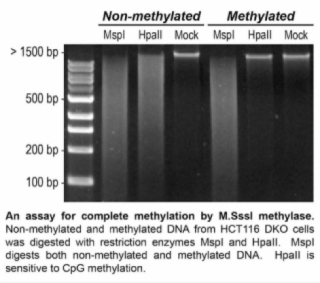Specially designed DNA standards and controls may not be flashy, but they are essential for correct experimental design and successful data analysis and without that, you’re going to be struggling to nab that next big publication.
But don’t worry, with the proper controls you’ll be able to pinpoint experimental issues with laser precision, not to mention make more sense of your data and increase the confidence in your results.
Sound too good to be true? Well the control freaks at Zymo Research have developed a suite of DNA Standards and Controls to help you keep your DNA methylation experiments under wraps.
Here’s a run down of the types of standards and controls available as well as some helpful advice on how to put them to good use.
Clamp Down on Bisulfite Conversion Efficiency
When using bisulfite conversion (especially home-brew), anyone can have a bad day and when your conversion is off, you need to know about it.
Zymo Research offers several products to gauge the efficiency and “completeness” of DNA/bisulfite conversion reactions. Simply include one of the appropriate DNA standards into a bisulfite reaction, in parallel with your samples, and you will be able to accurately control for the conversion process. This is facilitated by each standard having a defined methylation status, which allows conversion efficiency to be evaluated in the downstream analysis of choice. The standards are ideal for a broad range of applications including:
- Checking bisulfite PCR primer design
- Optimizing bisulfite PCR and sequencing reactions
- Generating methylated DNA standard curves for quantitation (Tse et al., 2011)
Each DNA set and standard is conveniently paired with a primer set designed to amplify a fragment of the DNA following bisulfite conversion. These standards are compatible with the EZ DNA Methylation™, EZ DNA Methylation-Gold™, EZ DNA Methylation-Direct™, or EZ DNA Methylation-Lightning ™ bisulfite conversion kits (Hernandez et al., 2013 and Van der Auwera et al., 2010) as well as most homebrew methods.
Standards Derived from Double-Knock-out (DKO) HCT116
Methylated and non-methylated genomic DNAs are convenient standards designed to determine DNA methylation levels as well as to monitor conversion efficiency in your assays. The completely methylated and non-methylated DNAs can be mixed to generate a standard curve for suitable quantitation of DNA methylation in your samples.
Human Methylated & Non-methylated DNA Set (D5014)
This control set contains DKO HCT116 non-methylated genomic DNA as well as enzymatically methylated (in vitro) DNA that has been methylated at every CpG site using CpG methylase.
Human WGA Methylated & Non-methylated DNA Set (D5013)
This control set is generated from DKO HCT116 non-methylated genomic DNA using whole-genome amplification (WGA) technology. This standard is ideal for studying loci with ultra-low methylation levels. Like the D5014 set, an enzymatically methylated DNA is included.
Standards Derived from Human and Mouse Tissues
Universal Methylated Human (D5011) and Mouse (D5012) DNA Standards
Provides a single completely methylated DNA from the species of interest. These genomic DNAs have been completely methylated at every CpG site, such that the methylation patterns are clearly defined. Also, Zymo Research offers a Bisulfite-Converted Universal Methylated Human DNA Standard (D5015). It is designed for use as a control for bisulfite mediated conversion of DNA and especially downstream analyses including PCR, MSP, and other amplification-based assays.
Leave No Base Unchecked: Additional Controls and Standards for DNA Methylation and Hydroxymethylation Analysis
In addition to the above standards, Zymo Research offers a number of controls and standards for use in qPCR, LC-MS, HPLC, and immuno-based assays including ELISA and dot blots.
5-Methylcytosine & 5-Hydroxymethylcytosine DNA Standard Set (D5405)
This extremely versatile standard set is ideal for the development of calibration curves for a number of assays such as qPCR, LC-MS, and HPLC. A unique feature of the 5-Methylcytosine & 5-Hydroxymethylcytosine DNA Standard Set is that it is a group of three linear 897 bp long dsDNA oligos containing the same sequence, but varying in their cytosine modifications. The cytosines are either unmodified, 5-methylcytosine (5-mC), or 5-hydroxymethylcytosine (5-hmC). This allows for the comparison of 5-mC and 5-hmC levels in any DNA to be interrogated. (Ivanov et al., 2013)
Human Matched DNA Set (D5018)
This standard is comprised of a set of organ-specific human genomic DNAs derived from a single individual. These DNAs serve as an ideal control for 5-mC and 5-hmC detection and quantification, since cytosine and its methylated and hydroxymethylated counterparts are present at tissue-specific loci and in biologically relevant levels (Skiriute et al., 2014).
Mouse 5-hmC & 5-mC DNA Set (D5019)
Similar to the human set, the mouse genomic DNA standards function as the perfect control for detection and quantification of 5-mC and 5-hmC your mouse DNA sample. 5-hmC and 5-mC levels within this DNA standard set have been precisely quantified using mass spectrometry (LC/MS) and thoroughly validated by ELISA to ensure the most consistent results.
Be a Control Freak
Now that you’ve seen the wide assortment of standards and controls for DNA methylation analysis, there’s really no excuse for not having a finger on the pulse of your experimental performance. Select the ones that will work best in your system, or consult the experts at Zymo Research who can help point you in the right direction.
Citations:
- Hernandez et al., 2013. Optimizing methodologies for PCR-based DNA methylation analysis. Biotechniques 55: 181-197
- Van der Auwera et al., 2010. Array Based DNA Methylation Profiling for Breast Cancer Subtype Discrimination. Plos One. DOI: 10.1371/journal.pone.0012616
- Tse et al., 2011. A refined, rapid and reproducible high resolution melt (HRM)- based method suitable for quantification of global LINE-1 repetitive element methylation. BMC Research Notes 4:565
- Ivanov et al., 2013. Ontogeny, distribution and potential roles of 5-hydroxymethylcytosine in human liver function.
- Skiriute et al., 2014. Glioma Malignancy-Dependent NDRG2 Gene Methylation and Downregulation Correlates with Poor Patient Outcome. J Cancer, 5(6): 446-456

